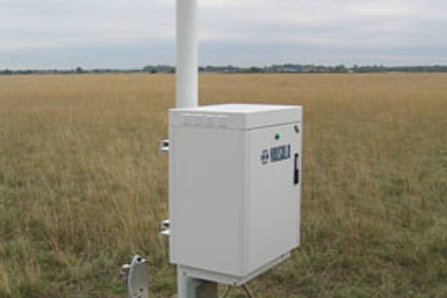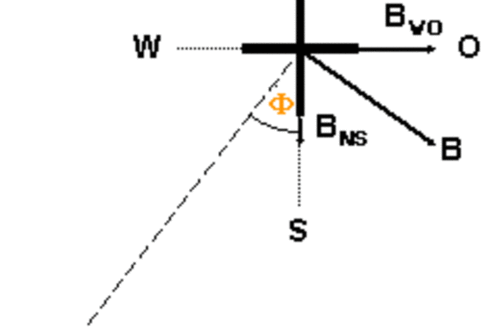Principle of Operation
A lightning location system basically consists of three components:
- three or more sensors which determine the angle of incidence of the lightning electromagnetic field and/or the exact time of occurrence
- central lightning processor (LP) to calculate the flash strike position
- a display system for the graphical presentation of the lightning activity
The GPS time stamped sensor data is transmitted to the lightning processor (LP). The first task of the lightning processor is to correlate data of the same lightning stroke based on the time information. It is important to note that at least two sensor messages are required to be able to calculate a flash location. Additional to the flash location the LP provides some supplementary information about the detected stroke:
- time
- polarity (positive/negative)
- stroke peak current in kA
Calculation of the stroke location
Magnetic Direction Finding (MDF): The striking position can be determined by triangulation using two sensors. If three or more sensors report a discharge, an optimization which minimizes the "angle disagreement" between the reporting sensors can be employed.
Time of Arrival (TOA): A constant difference in the arrival time at two stations defines a hyperbola. Multiple stations provide multiple hyperbolas whose intersections define a source location.
IMPACT (IMProved Accuracy using Combined Technology) combines direction-finding and time-of-arrival to produce yet another lightning location method. In this approach, direction finding provides azimuth information and absolute arrival time provides range information. These measurements produce three estimated parameters: latitude, longitude and discharge time. Thus, the IMPACT method has redundant information which allows for an optimized estimate of location even if only two sensors provide both timing and angle information.
Location accuracy
The location accuracy of a single lightning stroke depends on many different parameters, e.g., the number of sensors involved, the distance to the sensors and the random error of the angle and the time measurement. For all detected lightning strokes in Austria a median location accuracy of better than 500 meters has been confirmed by ground truth measurements at the Gaisberg Tower.
Sensor
A lightning location sensor determines angle of incidence and precise arrival time (accuracy better than 100 nanoseconds) of the electromagnetic field pulse emitted by the discharge.
In the direction finder (DF) two crossed magnetic loop antennas are used to measure the north-south and east-west component of the magnetic field. An electric flat plate antenna is used to determine the field polarity. The signal waveform of the magnetic loop antenna is also used to distinguish between cloud to ground (CG) discharges and other signals like intra- and intercloud lightning. The angle of incidence of the field of the lightning return stroke is calculated from the ratio of the signals from the magnetic loop antennas.
To discriminate CG and CC signals from any other signals, the so called "Waveform Discrimination" is used. Waveform discrimination is a check of several criteria a field waveform has to satisfy. With this method, field signals from CG return strokes can be selected with high confidence from all the signals received by the sensor.

